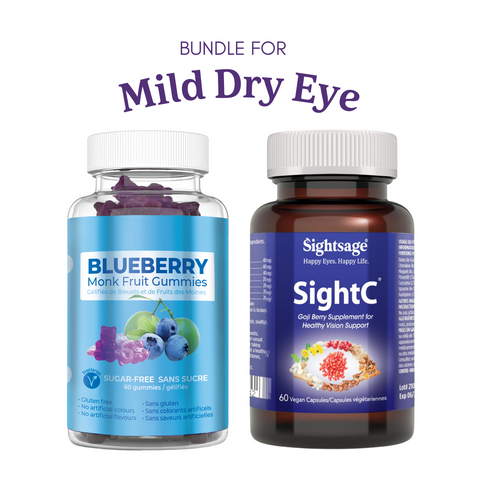How to Prevent Dry Eyes on Your Next Flight
Dry eyes while flying or after landing? It’s not the best way to start your trip. Dry eye disease and air travel happen more often than frequent travelers would like. But while some of its causes are beyond your control, some preventive measures can make even long flights manageable.
Even if you develop dry eyes after flying, you can still find relief from your symptoms – and give your tear glands a welcome nutrient boost.
In this post, we delve into why dry eye disease and air travel are linked and look at the best ways to avoid dry eyes on a plane. Whether you’re a frequent flyer and concerned about eye health or your eyes just feel bad after your last flight, we have you covered.
Why Does Dry Eye Occur During Air Travel?
One of the most common dry eyes causes is low humidity. Planes pull air from their engines to fill the cabins. This is known as bleed air and has low moisture levels. Compounding the problem are air vents that can direct air straight at your eyes, further increasing the rate at which your tears evaporate.
A 2023 scientific paper on eye disease and international travel notes that the low humidity inside planes can significantly affect the surface of the eye, leading to dryness and discomfort.

Other ocular symptoms you may experience on a plane include itching, pain, and eye watering, all of which can be dry eye disease symptoms. Headaches may also occur.
Water is the main component of the tear film that lubricates the surface of your eye at all times. Flying on a plane increases aqueous tear evaporation, a process that’s behind the most common form of dry eye disease.
Spending your time on a plane watching video, playing games on your phone or tablet, or reading a book only increase dry eye problems. These activities may alter blinking patterns, contributing to eye dryness.
Napping on a plane with your contacts on isn’t a good idea either. It deprives your eyes of oxygen and may attract airborne pollutants that can cause eye infections.
Dry eyes and related symptoms may last well after you have reached your destination. Some regular flyers may go on to develop chronic dry eyes or severe dry eye disease. It’s also possible for air travel to exacerbate existing dry eye symptoms.
How to Prevent Dry Eyes When Flying
You can take measures to reduce the risk of dry eye problems when flying. You may have no control over the humidity levels on a plane. But there’s still a lot you can do before, during, and after your flight to prevent dry eye syndrome.
- Wear glasses instead of contact lenses. You can switch back to contacts – if you must – after you reach your destination.
- Adjust the air vent (above your head). Air vents in a plane may feel refreshing, especially during a long flight. But if they are blowing air directly at your face, consider repositioning them. If you’re not sure how they work, don’t hesitate to ask the flight attendant for assistance.
- Use a sleep mask. Even if you’re not used to wearing sleep masks, taking one with you on a long flight is a good idea. It can help reduce the rate at which your eyes lose moisture and protect them from high-intensity air vents.
- Stay hydrated. When flying it’s easy to forget to stay hydrated. But drinking water and other hydrating beverages is good not only for general health but for your eyes too. Some studies have associated systemic dehydration with dry eyes in some people. Remember that alcohol, coffee, and even green tea can dehydrate you, so drink smart during your flight.
- Nourish your eyes with natural eye health supplements like SightC or Blueberry Gummies. Made with natural ingredients, Sightsage supplements provide your eyes with lutein, zeaxanthin, antioxidants, vitamins, and other essential nutrients your eyes and tear glands need to function at their best. Drop a bottle of SightC and Blueberry Gummies into your hand luggage and enjoy them before, during, and after your flight.

How to Find Relief from Dry Eyes After Flying
If you have already developed dry eye disease, you can soothe your symptoms and reduce the risk of the condition progressing toward severe dry eye. Here are a few things that can help.
- Apply a warm compress once you reach your destination. It provides moisture to the eyes and stimulates tear production. Check our guide on warm versus cold compresses for more on this.
- Wear sunglasses or prescription glasses with UV protection. UV radiation may cause oxidative stress and increase tear evaporation, both of which can contribute to dry eye disease.
- Rest your eyes. Before you head out for some fun, allow your eyes to rest at least for a day or two. Avoid overusing screens and stay away from environmental conditions that could worsen your symptoms, like a windy beach.
- Get good sleep. Sleep is essential for your body to repair and recover, and your eyes are no exception.
- Take an eye health supplement. Natural eye health supplements like Blueberry Gummies and SightC can soothe dry eye symptoms. If you are experiencing severe dry eyes, adjust your dose accordingly.
Wrap Up
Dry eyes on a plane can be unpleasant, but there’s a lot you can do to prevent dry eye syndrome or at least reduce the severity of the symptoms you’re experiencing. Frequent or long flights shouldn’t leave you dreading dry eyes.
Rest, warm compresses, and natural eye health supplements are some of the best ways to soothe dry eyes. With that said, if dry eyes after flying is a constant problem for you, don’t hesitate to schedule an appointment with an eye doctor. Dry eye syndrome is easier to keep in check when caught early.

